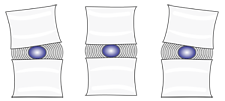The Intervertebral Disc
 The vertebral column protects the spinal core just as the
skull protects the brain. While the spine protects and
supports, it is also flexible due to its segmentation.
Between each bony segment, or vertebra, is a cartilage pad called an intervertebral disc (with the exception of
the top most vertebra). Each of the twenty-three discs
in your spine serve as connectors, weight bearers,
shock absorbers and provide flexibility. The disc is
composed of two portions.
The vertebral column protects the spinal core just as the
skull protects the brain. While the spine protects and
supports, it is also flexible due to its segmentation.
Between each bony segment, or vertebra, is a cartilage pad called an intervertebral disc (with the exception of
the top most vertebra). Each of the twenty-three discs
in your spine serve as connectors, weight bearers,
shock absorbers and provide flexibility. The disc is
composed of two portions.
 The central portion is a pulpy, gel-like material called the nucleus pulposus. The nucleus serves as a pivotal ball bearing between one vertebra and another. Forming a flexible, closed container around the nucleus is the annulus fibrosus. The annulus consists of cartilage rings which adhere strongly to each adjacent spinal bone. The intervertebral discs have virtually no blood supply and rely upon motion to remain healthy. Motion in the spine causes pumping action to each disc which allows nutrients to enter in, and wastes to be expelled out.
The central portion is a pulpy, gel-like material called the nucleus pulposus. The nucleus serves as a pivotal ball bearing between one vertebra and another. Forming a flexible, closed container around the nucleus is the annulus fibrosus. The annulus consists of cartilage rings which adhere strongly to each adjacent spinal bone. The intervertebral discs have virtually no blood supply and rely upon motion to remain healthy. Motion in the spine causes pumping action to each disc which allows nutrients to enter in, and wastes to be expelled out.
The Spine and the Nervous System
At the level of each spinal bone exists a spinal nerve. Each spinal nerve controls a variety of body functions. Due to the incredible complexity of the nervous system, only the general and most common relationships between the spine and nervous system are represented on this chart.
 |
 |
Click on image(s) for a larger view of the "Nerve Chart" and the "Anatomy of the Vertical Column |
|
